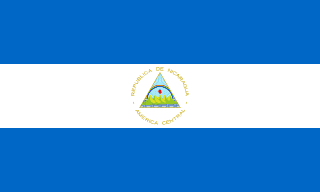Nicaragua - Economy

How is the economy of Nicaragua? Based on the information we have, Nicaragua has a low-income Central American economy; until 2018, nearly 20 years of sustained GDP growth; recent struggles due to COVID-19, political instability, and hurricanes; significant remittances; increasing poverty and food scarcity since 2005; sanctions limit investment. Key agricultural products in this country include: sugarcane, milk, rice, oil palm fruit, maize, plantains, cassava, groundnuts, beans, chicken (2023).
More about the economy of Nicaragua
| Labor force | 3.225 million (2024 est.) |
|---|---|
| Industrial production growth rate | 3.6% (2024 est.) |
| Industries | food processing, chemicals, machinery and metal products, knit and woven apparel, petroleum refining and distribution, beverages, footwear, wood, electric wire harness manufacturing, mining |
| Population below poverty line | 24.9% (2016 est.) |
| Taxes and other revenues | 19.9% (of GDP) (2023 est.) |
| Fiscal year | |
| Exchange rates | |
| Currency | cordobas (NIO) per US dollar - |
| Exchange rates 2024 | 36.624 (2024 est.) |
| Exchange rates 2023 | 36.441 (2023 est.) |
| Exchange rates 2022 | 35.874 (2022 est.) |
| Exchange rates 2021 | 35.171 (2021 est.) |
| Exchange rates 2020 | 34.342 (2020 est.) |
| Debt - external | |
| Debt - external 2023 | $6.753 billion (2023 est.) |
| Reserves of foreign exchange and gold | |
| Reserves of foreign exchange and gold 2024 | $6.105 billion (2024 est.) |
| Reserves of foreign exchange and gold 2023 | $5.447 billion (2023 est.) |
| Reserves of foreign exchange and gold 2022 | $4.404 billion (2022 est.) |
| Current account balance | |
| Current account balance 2024 | $817.618 million (2024 est.) |
| Current account balance 2023 | $1.465 billion (2023 est.) |
| Current account balance 2022 | -$459.6 million (2022 est.) |
| Public debt | |
| Public debt 2017 | 33.3% of GDP (2017 est.) |
| Budget | |
| Revenues | $3.856 billion (2023 est.) |
| Expenditures | $3.382 billion (2023 est.) |
| Budget surplus (+) or deficit (-) | |
| Remittances | |
| Remittances 2024 | 26.6% of GDP (2024 est.) |
| Remittances 2023 | 26.2% of GDP (2023 est.) |
| Remittances 2022 | 20.6% of GDP (2022 est.) |
| Imports | |
| Imports 2024 | $11.437 billion (2024 est.) |
| Imports 2023 | $10.519 billion (2023 est.) |
| Imports 2022 | $10.213 billion (2022 est.) |
| Imports (partners) | USA 24%, China 13%, Mexico 9%, Honduras 9%, Guatemala 8% (2023) |
| Comodities Imports force | garments, refined petroleum, crude petroleum, plastic products, fabric (2023) |
| Exports | |
| Imports 2024 | $11.437 billion (2024 est.) |
| Imports 2023 | $10.519 billion (2023 est.) |
| Imports 2022 | $10.213 billion (2022 est.) |
| Exports (partners) | USA 51%, Mexico 12%, El Salvador 6%, Canada 6%, Switzerland 4% (2023) |
| Comodities Exports force | garments, gold, insulated wire, coffee, beef (2023) |
| Real GDP (purchasing power parity) | |
| Real GDP (purchasing power parity) 2024 | $52.989 billion (2024 est.) |
| Real GDP (purchasing power parity) 2023 | $51.153 billion (2023 est.) |
| Real GDP (purchasing power parity) 2022 | $48.985 billion (2022 est.) |
| GDP (official exchange rate) | $19.694 billion (2024 est.) |
| Real GDP Per capita | |
| Real GDP per capita 2024 | $7,700 (2024 est.) |
| Real GDP per capita 2023 | $7,500 (2023 est.) |
| Real GDP per capita 2022 | $7,300 (2022 est.) |
| GDP - composition, by sector of origin | |
| Agriculture | 14.4% (2024 est.) |
| Industry | 27.6% (2024 est.) |
| Services | 46.8% (2024 est.) |
| GDP - composition, by end use | |
| Household consumption | 80.6% (2024 est.) |
| Government consumption | 12.3% (2024 est.) |
| Investment in fixed capital | 22.9% (2024 est.) |
| Investment in inventories | 1.8% (2024 est.) |
| Exports of goods and services | 40.5% (2024 est.) |
| Imports of goods and services | -58.1% (2024 est.) |
| Unemployment rate | |
| Unemployment rate 2024 | 4.6% (2024 est.) |
| Unemployment rate 2023 | 4.8% (2023 est.) |
| Unemployment rate 2022 | 5% (2022 est.) |
| Youth unemployment rate (ages 15-24) | |
| Total | 9% (2024 est.) |
| Male | 7.8% (2024 est.) |
| Female | 12% (2024 est.) |
All Important Facts about Nicaragua
Want to know more about Nicaragua? Check all different factbooks for Nicaragua below.









